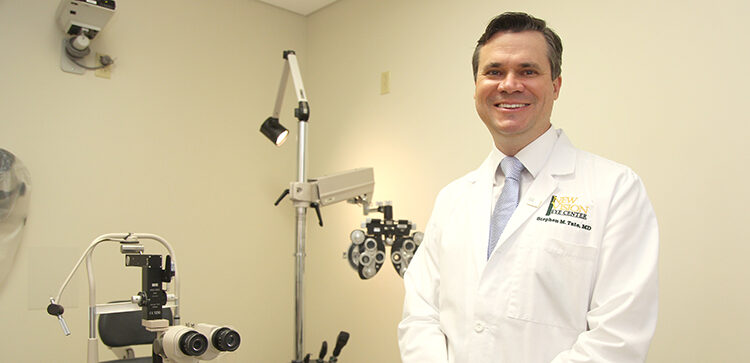
One of the most common sight problems experienced by older people is cloudy vision due to cataracts. Astigmatism is another widespread eye problem, affecting one in three people.
Now, increasingly, thanks to advances in eye surgery, skilled physicians are able to replace a clouded lens and correct astigmatism simultaneously.
According to Dr. Stephen M. Tate of New Vision Eye Center in Vero Beach, the biggest change in eye surgery in the past few years is the increasing use of computer guidance and tracking systems, and computer measurement systems during cataract surgery that enable the surgeon to correct astigmatism at the same time using an advanced femtosecond laser that replaces the use of handheld surgical tools.
Cataracts form on the lens behind the iris, the structure in the eye which allows the light to focus into the retina. A clear lens allows an image to focus light precisely onto the retina and send a clear image to the brain, while a cloudy lens will distort vision. People with cataracts often see halos around lights, double vision and disruptive glare from headlights, making it difficult to drive at night. Left untreated, cataracts can lead to legal blindness.
“Astigmatism occurs when the front part of the eye is oval shaped rather than being perfectly round,” explained Dr. Tate. “The front part of the eye is called the cornea and it helps to focus the light. In an ideal situation, the cornea is round, and all of the light would focus in one spot in the retina at the back of the eye. When you have astigmatism and the cornea is a bit oval, you’ll have two separate focal points in the eye instead of one, often resulting in the need to wear glasses.
“The condition can be corrected with LASIK surgery, but if someone is getting cataract surgery it can now be done at the very same time using our advanced laser cataract system so you don’t have to undergo two separate procedures.”
Basic cataract surgery is an extremely common procedure where the doctor most often removes the natural lens that has become clouded and replaces it with a clear intraocular lens.
The dual surgery can be done one of two ways. Both ways employ the use of advanced computer measurement and tracking systems during surgery. Once a cataract is removed from the eye, a measurement using this system reveals how much astigmatism the patient has. It also shows its orientation, revealing whether the oval shape is horizontal, vertical or diagonal. Once the surgeon has that precise information, it can be treated.
“If someone has a relatively small amount of astigmatism, we can treat by making small grooves, called limbal relaxing incisions, outside of the cornea where the white part meets the colored part of the eye,” Dr. Tate continued. “These incisions are designed to return the cornea to its proper shape, which in turn allows that light to pass through the eye properly. The nice thing about the computerized system is that it gives the surgeon a heads-up display to use during surgery. Once it takes the measurement, it basically puts a template on the eye that the surgeon can trace to effectively reduce out the astigmatism.”
People with larger astigmatism that must be corrected with grooves now have the option of having lens implants with the astigmatism correction built into them. Using the same system, a similar measurement is taken that will tell how much astigmatism there is, as well as its orientation. The corrective lens implants need to be aligned in a precise, specific way, so the computer system once again gives a heads-up display of the surface of the eye and allows the surgeon to orient the lens in the proper location to cancel out the astigmatism.
“Cataracts happen so slowly that people won’t even notice them until they are advanced,” added Dr. Tate. “Some people are born with them and they can develop at any age, but most of the patients we see are in their 60s. The good news is that cataract surgery will last a lifetime, even if it its administered to a child.”
The surgery usually only lasts about 10 minutes and most patients are home within an hour. “It really isn’t painful at all, but because most people are nervous about anything touching their eyes, we give people sedation,” explained Dr. Tate. “Younger people have softer cataracts, so their vision recovers very quickly. Older people have denser and harder cataracts that require more energy to break up during surgery so they may experience some natural swelling. Most see more clearly the first day and are able to resume normal activities and then their vision improves even more, slowly but surely, after that.”
While there are no preventative measures that can ward off cataracts, there is some correlation between UV exposure and cataracts, so wearing sunglasses at an early age may help. Getting a yearly eye exam is the biggest preventative measure anyone can take because the longer an issue goes undetected, the more issues it can cause.
Dr. Stephen M. Tate is a Board-Certified Ophthalmologist specializing in custom cataract surgery, laser cataract surgery, astigmatism correction, glaucoma treatment, retinal management and general ophthalmic care. He can be reached at New Vision Eye Center, 1055 37th Place, Vero Beach, 772-257-8700.



